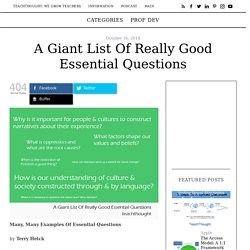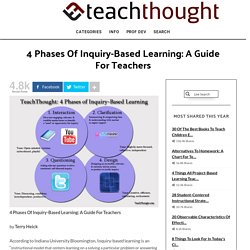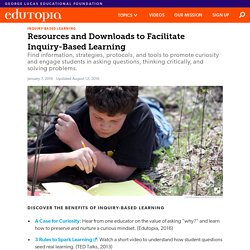

Many, Many Examples Of Essential Questions. Many, Many Examples Of Essential Questions by Terry Heick Essential questions are, ask Grant Wiggins defines, “‘essential’ in the sense of signaling genuine, important and necessarily-ongoing inquiries.”

These are grapple-worthy, substantive questions that not only require wrestling with, but are worth wrestling with–that could lead students to some critical insight in a 40/40/40-rule sense of the term. I collected the following set of questions through the course of creating units of study, most of them from the Greece Central School District in New York. In revisiting them recently, I noticed that quite a few of them were closed/yes or no questions, so I went back and revised some of them, and added a few new ones, something I’ll try to do from time to time. Or maybe I’ll make a separate page for them entirely. Decisions, Actions, and Consequences What is the relationship between decisions and consequences? Social Justice What is social justice? Culture: Values, Beliefs & Rituals Creation. Cybraryman Internet Catalogue. 4 Phases of Inquiry-Based Learning: A Guide For Teachers.
4 Phases Of Inquiry-Based Learning: A Guide For Teachers by Terry Heick According to Indiana University Bloomington, Inquiry-based learning is an “instructional model that centers learning on a solving a particular problem or answering a central question.

There are several different inquiry-based learning models, but most have several general elements in common: Learning focuses around a meaningful, ill-structured problem that demands consideration of diverse perspectivesAcademic content-learning occurs as a natural part of the process as students work towards finding solutionsLearners, working collaboratively, assume an active role in the learning processTeachers provide learners with learning supports and rich multiple media sources of information to assist students in successfully finding solutionsLearners share and defend solutions publicly in some manner” The process itself can be broken down into stages, or phases, that help teachers frame instruction. 1. Student-to-material. 2. 3. Inquiry-Based Learning: Developing Student-Driven Questions. Defining Inquiry Inquiry-based learning, rather than presenting a set of facts, uses student inquiries, questions, interests, and curiosities to drive learning.
This level of student involvement makes the learning more relevant, encouraging students to develop their own agency and critical thinking skills. The Inspiration Wildwood was already using inquiry-based learning to some extent, but things took off for them when, in Principal Mary Beth Cunat's second year, the school put on an Inquiry Fair. The event was similar to a science fair, where students demonstrated their personal inquiries/projects and results, some of which aligned with unit content and some of which drew from their own personal interests. "All of the sudden, we see our students doing things that really matter to them, and they're excited and they're passionate, and they want to talk about what they're learning," says Cunat. It All Starts With Questions. Teaching Students to Ask Their Own Questions.
Students in Hayley Dupuy’s sixth-grade science class at the Jane Lathrop Stanford Middle School in Palo Alto, Calif., are beginning a unit on plate tectonics.

In small groups, they are producing their own questions, quickly, one after another: What are plate tectonics? How fast do plates move? Why do plates move? Do plates affect temperature? What animals can sense the plates moving? Far from Palo Alto, in the Roxbury neighborhood of Boston, Mass., Sharif Muhammad’s students at the Boston Day and Evening Academy (BDEA) have a strikingly similar experience. These two students—one in Palo Alto, the other in Roxbury—are discovering something that may seem obvious: When students know how to ask their own questions, they take greater ownership of their learning, deepen comprehension, and make new connections and discoveries on their own.
The origins of the QFT can be traced back 20 years to a dropout prevention program for the city of Lawrence, Mass., that was funded by the Annie E. Spotlight Inquiry Based Teaching Learning 2017 Sponsored. Resources and Downloads to Facilitate Inquiry-Based Learning. A Case for Curiosity: Hear from one educator on the value of asking “why?”

And learn how to preserve and nurture a curious mindset. (Edutopia, 2016) 3 Rules to Spark Learning: Watch a short video to understand how student questions seed real learning. (TED Talks, 2013) Why Curiosity Enhances Learning: Read about findings of a neurological study on curiosity. (Edutopia, 2014) Designing Learning That Matters: Learn about the benefits of inquiry-driven, deep-learning experiences. (Edutopia, 2015) The Research Behind Choice and Inquiry-Based Education: Explore a collection of research and success stories. Create Learning Environments That Foster Inquiry How to Bring ‘More Beautiful’ Questions Back to School: Take a look at five ways to create learning environments that value questions. Plan Curriculum That Supports Inquiry Use Strategies to Increase Inquiry in the Classroom Curiosity: The Force Within a Hungry Mind: Explore ten ways to encourage students to be curious. Video.